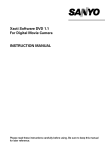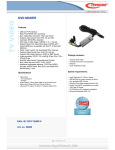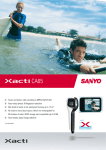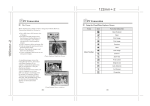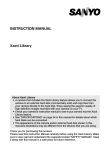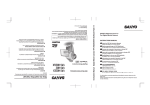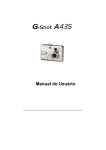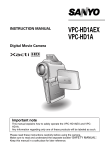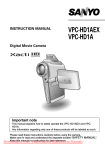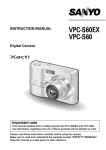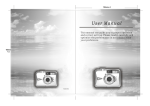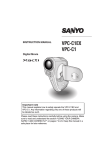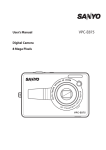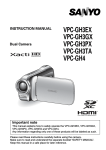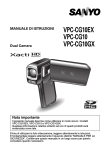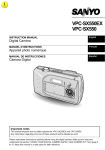Download SANYO Software Pack 7.7 For Digital Movie Camera INSTRUCTION
Transcript
SANYO Software Pack 7.7 For Digital Movie Camera INSTRUCTION MANUAL Please read these instructions carefully before using. Be sure to keep this manual for later reference. ATTENTION Regarding permission to use the CD-ROM h This CD-ROM may not be reproduced without permission. h When installing the software in this CD-ROM, permission is granted for its use only if the user agrees to the terms and conditions that are displayed at the start of installation. h Regarding products by other manufacturers that are specified on this CD-ROM, and for service, please inquire of the respective manufacturer. i It is strictly forbidden to copy this manual, wholly or in part, without prior written permission. i The contents of this manual are subject to change without prior notice. i Sanyo Electric shall not be held responsible for any problems resulting from the use of this product. i Sanyo Electric declines all responsibility for damages due to improper use of this product, failure to adhere to the instructions given in this manual, or repairs or changes done by those other than a technician authorized by the manufacturer. i Sanyo Electric shall not be held responsible for any damage caused by optional devices or consumable items used with this product other than those supplied with this product or those specified by Sanyo Electric. i Sanyo Electric shall not be held responsible for any losses or loss of revenue resulting from the loss of data caused by the malfunction, or the repairing of a malfunction, of this product. i English COPYRIGHTS This manual and the software are copyrighted materials from Sanyo Electric Co., Ltd. PowerPC is a registered trademark of International Business Machines Corp. (USA) Macintosh and QuickTime are registered trademarks of Apple Computer, Inc. in the USA and other countries. Microsoft and Windows are registered trademarks of Microsoft Corporation in the USA and other countries. DirectX is a registered trademark of Microsoft Corporation in the USA and other countries. Intel and Pentium are registered trademarks of Intel Corporation (USA). All other brand or product names mentioned in this manual are trademarks or registered trademarks of their respective companies. 1 English CONTENTS INTRODUCTION ....................................................................................3 About this manual ............................................................................3 The software ....................................................................................4 CD-ROM directory map ...................................................................5 OPERATING ENVIRONMENT ...............................................................6 Windows ..........................................................................................6 Macintosh ........................................................................................7 BEFORE MOUNTING YOUR CAMERA .................................................8 Cautions when using the camera as an external drive ....................8 Operating environment ....................................................................8 Data file formats ..............................................................................9 Configuration of directories in the card ..........................................10 Setting to the card reader mode ....................................................11 To play back in the HD mode or a 60 fps video clip ......................12 For Windows XP users ..................................................................13 For Windows Me/Windows 2000 users .........................................14 For MAC OS 9.xx users ................................................................15 For MAC OS X users .....................................................................15 INSTALLING THE APPLICATION SOFTWARE ..................................16 Windows ........................................................................................17 Macintosh ......................................................................................18 HOW TO USE Photo Explorer ..............................................................19 Set up the environment .................................................................19 Copying image data to a computer ...............................................21 USING AS A PC CAMERA ...................................................................23 Before connecting your camera to a computer .............................23 Connect your camera to a computer .............................................24 ABOUT MovieFactory ...........................................................................26 Main features .................................................................................26 Additional features .........................................................................27 ABOUT Motion Director ........................................................................28 Importing .......................................................................................28 Output format and playback ..........................................................28 English 2 INTRODUCTION This manual describes how to install and operate the SANYO Software Pack. Please read this manual carefully, in order to use the images and audio recordings captured with your camera in a wide range of applications. About this manual The explanations in this manual conform to the following conventions. i The examples given in this manual are generally based on a Windows environment. For Macintosh users, while the menu names and screen indications may be different, this is no impediment to understanding the operation. In those places where the operations for Macintosh users and Windows users differ, specific explanations are provided. i In this manual, the SD Memory Card is referred to as “card”. h This manual is designed for users with the following computer skills: h Knowledge of basic computer operations h Knowledge of basic mouse operations h Knowledge of how to open, close, move, minimize and maximize windows h Knowledge of how to move from one folder to another folder Detailed information about the operations listed above can be found in the printed or online manuals accompanying the computer or operating system software. Symbols used in this manual HINT Extra information about software or cautionary notes. CAUTION Points requiring special attention. (page xx) Refer to the page indicated for detailed information. 3 English The software The following software applications are in the SANYO Software Pack. Please see page 16 for a summary of each software program. i QuickTime 7.0 In this manual, referred to as QuickTime. i Ulead Photo Explorer 8.5 SE Basic (Windows)/Photo Explorer for Mac 2.0 (Macintosh) In this manual, referred to as Photo Explorer. i Motion Director SE 1.1 (Windows) In this manual, referred to as Motion Director. i Ulead DVD MovieFactory 5.0 SE (Windows) In this manual, referred to as MovieFactory * PhotoExplorer and MovieFactory both support the MPEG-4 format. Installing these application software will allow you to view MPEG-4 files. English 4 CD-ROM directory map Below is a directory map of the SANYO Software Pack contents. <Windows> h Disc1 h Disc2 SanyoDisc1 (D:)* SanyoDisc2 (D:)* QuickTime PhotoExplorer MotionDirector DVD MovieFactory * The drive name (D:) may be different on your computer. <Macintosh> h Disc1 SanyoDisc PhotoExplorer 5 English OPERATING ENVIRONMENT The operating environments for the respective application software are as shown below. Concerning the operating environment when handling HD mode or 60 fps video clips, please see page 12. Windows Software CPU Pentium QuickTime or faster Photo Explorer Pentium III 800 MHz or faster Motion Director Pentium III 1 GHz or faster Movie Factory Pentium III 800 MHz or faster Other Memory 128 MB or more 256 MB or more (512 MB recommended) Hard drive OS 11 MB or more 950 MB or more Windows 2000 SP4 or later Windows XP SP2 or later 512 MB or more Direct X9.0 or later English 6 Macintosh Software Photo Explorer 7 English CPU Power PC or later Memory 64 MB or more Hard drive 20 MB or more OS Mac OS 9.0 or later (CarbonLib 1.4 or more); Mac OS X 10.1 or later BEFORE MOUNTING YOUR CAMERA The following is an explanation of the format of data recorded by your camera, as well as the configuration of directories in the card. Cautions when using the camera as an external drive i Do not alter files or folders in your camera in any way. Doing so may result in your camera not recognizing that data. If you want to edit files, first copy them to your computer’s hard drive. i Cards formatted on your computer cannot be used by your camera. Format all cards to be used by your camera with your camera. Operating environment Windows A computer with a standard-equipped USB port, and preinstalled with Windows 2000, Me or later is required. Correct operation cannot be guaranteed for models with upgraded Windows systems. Macintosh A model with a standard-equipped USB port, and preinstalled with Mac OS 9.0, 9.1, 9.2, Mac OS X 10.1 or later is required. English 8 Data file formats The format of the files saved on the card and the method in which the file names are determined are explained below. Type of data Still image data Video clip data Audio recording data Data format File name structure File name begins with SANY. JPEG Extension is “.jpg”. SANY****.jpg File name begins with SANY. MPEG-4 Extension is “.mp4”. SANY****.mp4* File name begins with SUND. MPEG-4 Audio Extension is “.m4a”. (AAC compression) SUND****.m4a* * Consecutive numbers assigned in the order the data was saved. 9 English Configuration of directories in the card ROOT DCIM 100SANYO SANY0001.jpg Folder number MISC (Location of DPOF files) Image number SANY0002.jpg SANY0003.mp4 SUND0004.m4a 101SANYO SANY0001.jpg SANY0002.jpg SANY0005.jpg Image or audio recording number SANY9999.jpg 102SANYO SANY0001.jpg SANY0002.jpg * Up to 9,999 files can be stored in folder 100SANYO. If more files are made, a folder named 101SANYO is created, and they will be stored in there. New folders will then be named in sequence, i.e., 102SANYO, 103SANYO, etc. HINT About the volume name i The volume name will be [XACTI HD1A] for a card that was formatted with the camera, and [Removable disc] for a card that was formatted with a computer. About video clip data recorded with this camera i You can use Apple’s QuickTime 6.3 or later version to play back video clips on a computer. Playback may also be possible using other software that supports the ISO standard MPEG-4 (AAC audio). QuickTime 7.0 for Windows is supplied with the included CD-ROM (SANYO Software Pack). About audio data recorded with this camera i If you change the extension (.m4a) of audio data files to “.mp4”, playback may be possible using software that supports the ISO standard MPEG-4 (AAC audio). About file names when the card is replaced... i If the file number reset function is set to off, even when the card is replaced, consecutive numbering of folder numbers and file names continues from the previously installed card (see page 141 in the camera’s instruction manual). CAUTION If you intend to view the images on the camera, do not use a computer to rewrite the card data. i If the folders, file names, or their configuration is modified using a personal computer, it will be impossible to play back the data using the camera, and the camera may not operate properly. English 10 Setting to the card reader mode 1 Start your computer, and use the supplied USB interface cable to connect the docking station to the computer. h Connect the docking station’s USB/AV terminal to the computer’s USB connector. 2 Press the ON/OFF button to turn the camera on, and set the camera in the docking station. h The USB Connection Screen appears on the camera’s monitor. USB CONNECTION CARD READER PictBridge PC CAMERA CANCEL USB/AV terminal To AC adaptor To USB connector on the computer Supplied dedicated USB interface cable i Insert the plug with the [n] mark facing up. 3 Select “CARD READER”, and press the SET button. h When the camera’s monitor unit is closed and the camera is set in the docking station, press the operation mode button [ ] on the docking station. 11 English CAUTION Insert and pull out the cable carefully i When connecting the cables, make sure that the cable plugs are correctly oriented and that they match the shapes of the terminal sockets on the devices. Push the plugs in straight when connecting them. If undue force is used to connect a cable, it may permanently damage the connector pins in the terminal socket. i Do not use excessive force when connecting and disconnecting cables. i Please connect the dedicated USB interface cable to your computer’s USB connector. Do not connect it to the USB port on your monitor or keyboard, or to the USB hub. Be especially careful when installing the driver software. In some instances, it may not be possible to correctly install the driver software. To play back in the HD mode or a 60 fps video clip The computer or application software operating environment to play back video clips recorded in the U, V or T mode is as shown below. Windows® OS* CPU Memory Video memory Windows® 2000 SP4 or later/ Windows® XP SP2 or later (QuickTime 7.0.1 or later) UV Pentium 4, 3.0 GHz or more T Pentium 4, 2.4 GHz or more 512 MB or more (1024 MB or more recommended) 64 MB or more (128 MB or more recommended) Macintosh® Mac OS X 10.3.6 or later (QuickTime 6.5.2 or later) Power PC G5 1.6 GHz or more 512 MB or more 64 MB or more *: Limited to models with the operating system pre-installed. English 12 For Windows XP users Mounting your camera 1 Set the camera to the card reader mode (page 11). h The message [Found New Hardware] appears in the task tray, showing that the camera is recognized as a drive. h The card is recognized (mounted) as a disk, and the [XACTI HD1A (E:)] window opens. * The drive name (E:) may be different on your computer. 2 Select an action. h Select the desired procedure from the [XACTI HD1A (E:)] window. Dismounting the camera CAUTION i To disconnect your camera, be sure to follow the procedure below. Failure to follow this procedure may cause faulty operation of your computer or loss of card data. 1 Left-click on the icon for safely removing hardware. h A list appears showing the devices connected to the computer’s USB connector. 2 Left-click on the camera drive (E:). h The camera can now be disconnected. * The drive name (E:) may be different on your computer. 13 English For Windows Me/Windows 2000 users Mounting your camera 1 Set the camera to the card reader mode (page 11). h If a message appears on the computer monitor instructing you to load the Windows CD-ROM, follow the instructions and install the driver. h The camera is recognized as a drive, and [XACTI HD1A (E:)] appears in the [My Computer] window. * The drive name (E:) may be different on your computer. h The card is recognized (mounted) as a disk. h Double-click on the [XACTI HD1A (E:)] icon in [My Computer], and you can process the contents of the card installed in your camera exactly like you would the data in the other computer drives. Dismounting the camera CAUTION i To disconnect your camera, be sure to follow the procedure below. Failure to follow this procedure may cause faulty operation of your computer or loss of card data. 1 Left-click on [Unplug or Eject Hardware] in the task tray. h A list appears showing the devices connected to the computer’s USB connector. 2 Left-click on the camera drive (E:). * The drive name (E:) may be different on your computer. h The [Safe to Remove Hardware] dialog box will open. 3 Click on the [OK] button. h You can now disconnect the camera. English 14 For MAC OS 9.xx users Mounting your camera 1 Set the camera to the card reader mode (page 11). h The camera is recognized as a drive and appears as an icon named [XACTI HD1A] on the Desktop. h Double-click on the [XACTI HD1A] icon, and you can process the contents of the card installed in your camera exactly like you would the data in the other computer drives. Dismounting the camera CAUTION i To disconnect your camera, be sure to follow the procedure below. Failure to follow this procedure may cause faulty operation of your computer or loss of card data. 1 Drag the [XACTI HD1A] icon for your camera on the Desktop to the trashcan. h The [XACTI HD1A] icon disappears from the Desktop. h You can now disconnect your camera. For MAC OS X users Use the same mounting and dismounting procedure as for the MAC OS 9.xx. However, if an application which automatically recognizes camera images is installed, it will be activated. CAUTION When using in a Mac OS X Classic environment i It is not possible to save or load data directly to or from the card installed in the camera. The data must first be saved once to your hard disk. 15 English INSTALLING THE APPLICATION SOFTWARE The SANYO Software Pack contains the application software indicated below. Installation of each application will serve to optimize your use of the data recorded with your camera. i QuickTime*1 Play back video clips. The recorded audio is played back at the same time. Be sure to install this application if you are going to view video clips that were photographed with your camera (Windows). i Photo Explorer*2 Organizing the data recorded with your camera is easy to understand using the graphic screen. i MovieFactory*2 Use this integrated tool to store various files–such as video and music files, photo files, data files, etc.– to disc for processing with your computer. i Motion Director Use Motion Director to remove motion blur from video clips captured with your camera and to make a single panorama still shot from a video clip recorded while panning. *1 By upgrading from QuickTime to QuickTime Pro, you will be able to edit QuickTime movies, among other features. You can upgrade from Apple Computer, Inc.’s web page at http://www.apple.com. *2 If PhotoExplorer or MovieFactory is installed on your computer, you can use Windows Media Player to play back video clips (MPEG-4) that were recorded with your camera. For information about software updates, please refer to the following website: http://www.ulead.com/ English 16 Windows 1 Insert the CD-ROM (SANYO Software Pack Disc 1 or 2) in your computer’s CD-ROM drive. h The installation window soon appears. h If the installation window does not appear, double-click on the CDROM icon in the My Computer window, and double-click on [Autorun] or [Autorun.exe] in the CD-ROM window. 2 Click on the name of the application software you wish to install. h The window for beginning the installation procedure for the specified application will open. h The installer program for each application is preset to properly install the software. If you are unfamiliar with the computer, we recommend clicking the [Next] button at each screen. h If a user registration dialog box appears, do not enter anything in the [Enter your registration information] dialog box, and click on the [Next] button. h If a dialog box prompting you to restart your computer appears, restart your computer. You can find more information about the respective applications at: QuickTime: http://www.apple.com Photo Explorer: http://www.ulead.com 3 Click on [DONE]. HINT About Kodak online service i When the installation window closes, a dialog box to connect to the website introducing Kodak’s online service appears. To go to the website, select the [Tell me more now !] option button. If you do not wish to go to the website, select on the [No thanks !] option button. Click on the [OK] button. 17 English Macintosh Photo Explorer installation 1 Insert the CD-ROM (SANYO Software Pack Disc 1) in your computer’s CD-ROM drive. h The CD-ROM window will open after a few seconds. h If the window does not open, double-click on the CD-ROM icon [SanyoDSC] on the Desktop. 2 Install the Photo Explorer. h Open the [Photo Explorer] folder and copy the [English] folder (or whatever other language you prefer) to your hard disk. h When the folder has been copied, installation of the application is completed. HINT About the [Carbon Lib] folder i If your computer’s CarbonLib file (extension file) is earlier than version 1.4, please install the CarbonLib file (in the [Carbon Lib] folder) to the extension folder. English 18 HOW TO USE Photo Explorer To copy data from your camera to your computer, when you open the drive for your camera from [My Computer], options are shown for copying data to your computer and for using Photo Explorer to copy data. Explained in this section is how to use Photo Explorer to copy the camera’s data to your computer. For a detailed explanation of Photo Explorer, please see the Help menu of Photo Explorer. Set up the environment Specify the source of the data (data location in your camera) to be copied. k Windows 1 Set the camera to the card reader mode (page 11). h Open the [Ulead AutoDetector] dialog box. h If the window showing the contents of the card installed in the camera (XACTI HD1A (E):) is open, click on the [Close] button to close it. 2 In the [Ulead AutoDetector] dialog box, check the box [Always open with the selected program], and click on the [OK] button. h The [Copy file to...] dialog box will open. h If you check the [Always open with the selected program] box, the [Ulead AutoDetector] dialog box step will be skipped from the next time. 3 Turn ON the [Open Ulead Photo Explorer to view photos] option button, and click on the [OK] button. 4 Click on the digital camera wizard icon on the toolbar. h The [Digital Camera Wizard] dialog box will open. 5 Click on the drive name (A:\) to the right of [Camera drive or card reader]. h The [Select Image Source] dialog box will open. 6 Turn ON the [Camera drive or memory card reader] option button, select the camera drive from the [Location] list box, and click on the [OK] button. h The drive name to the right of [Camera drive or card reader] is changed to the drive specified in step 6. h If you wish to now read the data from the card installed in the camera, click on the [Start] button. The data from the card will be copied to My Documents\SANYO_PEX. h If instead you wish to discontinue after changing the settings, click on the [Cancel] button. h The [Digital Camera Wizard] dialog box will close. 19 English k Macintosh 1 Set the camera to the card reader mode (page 11). h The [XACTI HD1A] icon will appear on the desktop. 2 Open the folder in which Photo Explorer was installed, and doubleclick on the Photo Explorer program icon. h Run Photo Explorer. 3 Click on the digital camera wizard icon on the toolbar. h The [Digital Camera Wizard] dialog box will open. 4 Click on the icon in the [Camera flash disk drive] section. h The [Choose Removable Drive] dialog box will open. 5 Click on the drive for the camera connected to your computer (XACTI HD1A), and click on the [Select] button. h The drive name in the [Camera flash disk drive] section is changed to [XACTI HD1A]. 6 Turn ON the [Create subfolder] checkbox. h If you wish to now read the data from the card installed in the camera, click on the [Start] button. h If instead you wish to discontinue after changing the settings, click on the [Cancel] button. English 20 Copying image data to a computer Copy image files to the computer from the card installed in your camera. 1 Set the camera to the card reader mode (page 11). 2 Run Photo Explorer. 3 Click on the digital camera wizard icon on the toolbar. h The [Digital Camera Wizard] dialog box will open. 4 Click on the [Start] button. h Copying begins. h A folder with the name as indicated below is automatically created, to which the data is copied. Windows: My Documents\SANYO_PEX Macintosh: Macintosh HD:Ulead Photo Explorer h When copying is completed, the [Done] dialog box will appear. 5 When copying is completed, click on the [OK] button. h The copied data is shown in a thumbnail window. 21 English Photo Explorer features With the Photo Explorer you have visually integrated control over multiple files, from camera images to DV camcorder video files to audio files (such as MP3 and WAV files). k Manage and edit image files Viewing images Images can be viewed full-size or full-screen. Use the keyboard controls or toolbar buttons to select the menu, and you can browse the images or play them back, for example, in a slideshow. Organizing and editing images You can copy and erase image files, as well as change the file names. In addition, you can rotate and flip images, and save the edited images as new files. Adjusting images You can easily enhance images by clipping and adjusting the contrast, brightness, color balance, etc. The created images can be used for wallpaper or screen savers. k Abundant slideshow features Slideshows containing combinations of still images and video clips can be played back. k Convert the format of video clip data Video clips (QuickTime format) that were shot with your digital camera can be converted to other formats, such as AVI and MPEG. k For questions about Photo Explorer Further information about Photo Explorer can be found at http://www.ulead.com <Where to find the serial number> i From the Photo Explorer [Help] menu, select “About Ulead Photo Explorer”. The program version as well as the serial number are shown. English 22 USING AS A PC CAMERA If running Windows XP, you can connect the camera to a computer and use it as a PC camera. Before using your camera as a PC camera, please install Windows XP SP2. The PC camera functions can be used with Windows Messenger 5.0 or later version, or MSN Messenger 7.0 or later version. Before connecting your camera to a computer Please perform the following upgrades before connecting the camera to a computer. i Upgrade Windows XP to SP2. Install Windows XP SP2. i Install Windows Messenger 5.0 or later version. Download Windows Messenger 5.0 or later version, and install it. i If using MSN Messenger, please install MSN Messenger 7.0 or later version. CAUTION i The PC camera function can be used only with computers in which Windows XP was preinstalled. Correct operation cannot be guaranteed for models that have been upgraded to Windows XP. i The zoom cannot be used with the PC camera function. Moreover, only images can be recorded; audio data cannot be recorded. i Although your camera can shoot at a maximum rate of 15 frames per second, the rate at which you can broadcast in the PC camera mode may be less than this depending on the speed of your Internet connection. 23 English Connect your camera to a computer 1 Start your computer, and use the supplied USB interface cable to connect the docking station to the computer. h Connect the docking station’s USB/AV terminal to the computer’s USB connector. 2 Press the ON/OFF button to turn the camera on, and set the camera in the docking station. h The USB Connection Screen appears on the camera’s monitor. USB CONNECTION CARD READER PictBridge PC CAMERA CANCEL USB/AV terminal To AC adaptor To USB connector on the computer Supplied dedicated USB interface cable i Insert the plug with the [n] mark facing up. English 24 3 Select “PC CAMERA”, and press the SET button. CAUTION Insert and pull out the cable carefully i When connecting the cables, make sure that the cable plugs are correctly oriented and that they match the shapes of the terminal sockets on the devices. Push the plugs in straight when connecting them. If undue force is used to connect a cable, it may permanently damage the connector pins in the terminal socket. i Do not use excessive force when connecting and disconnecting cables. HINT If the [USB Video Device] icon does not appear in the [My Computer] window... i The device driver installation may not have been successful. Open the [Printer and Other Hardware] folder in [Control Panel], delete [USB Video Device] from [Scanners and Cameras], and reinstall the device driver. 25 English ABOUT MovieFactory MovieFactory is an integrated tool for processing and storing video, music, photo and data files to disc with your computer. The limited edition contained in the SANYO Software Pack comprises DVD authoring functions only. For information concerning how to use MovieFactory, click on [Program] → [Ulead DVD MovieFactory 5] → [User Manual], and select [DVD MovieFactory User Guide] to access the user’s manual. Main features i Create your own movie discs Create your own movies in DVD or Video CD format. Download image data from a DV camera, digital movie camera, digital camera, video tapes and TV programs, for example, add effects, and then save the edited data on a disc. i Edit HD mode video clips Now you can edit video clips that were recorded in the HD mode without converting the video files from the HD MPEG4 format. i Make slideshows Create a slideshow of the still images etc. captured with your digital camera, and store them to DVD or CD. Ideal for sorting and managing your photos. i Capture directly to disc Burn DVD discs directly from your DV camera, video tapes, TV programs, etc., while you view them in realtime. i Disc copy It’s easy to make disc-to-disc copies. Works for any kind of disc–DVDs, music CDs, MP3 files, your homemade discs, data discs. CAUTION i Note that MovieFactory cannot be used to successfully record to DVD from media which incorporate copy-protect or scrambling technologies to protect copyrights. English 26 Additional features i File format conversion Use MovieFactory to convert the file format and image quality, then save it. i Burn from disc images When burning a DVD video, save an image file of the same contents on your computer’s hard drive. Use this file to burn the data to disc. i Labels for your discs Print your own labels for your CDs and DVDs. (Blank labels for printing are available commercially.) k For questions about MovieFactory Further information about MovieFactory can be found at http://www.ulead.com/ <Where to find the serial number> i From the MovieFactory environment icons , select “About Ulead DVD MovieFactory”. The program version as well as the serial number are shown. 27 English ABOUT Motion Director Use Motion Director to remove motion blur from video clips captured with your camera and to make a single panorama still shot from a video clip recorded while panning. An outline of Motion Director is introduced below. For details, please refer to online help for Motion Director. Importing Motion Director can read either of these file formats: h MOV h MP4 The compression coding for each is as follows: Format MOV MP4 Video coding Motion JPEG ISO MPEG-4 Audio coding WAVE AAC The frame size is VGA (640 × 480 pixels) or less. Output format and playback Motion Director can write files in the following formats: Motion-blur correction: MPEG-4, MOV Panorama composite: JPEG, BMP, TIFF, QuickTime VR VR spatiotemporal images saved in the QuickTime VR format using Apple’s QuickTime Player can be viewed. English 28 SANYO Electric Co., Ltd.































